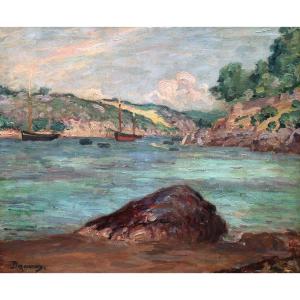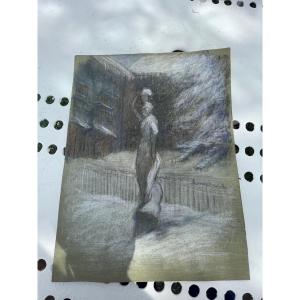René Pinard (1883-1938) is a painter-engraver born in Nantes. Son of the Nantes photographer Étienne-Marie Pinard, he grew up on rue Crébillon. His first drawings date from 1897. In 1901 and 1902, he took classes at the municipal drawing school of the city of Nantes, in Mr Gaucher's class. He entered the École des beaux-arts in Paris on October 15, 1902, and followed the classes of Fernand Cormon. In October 1906, he joined his teacher's etching workshop, where he won several awards in 1907 and 1908. In 1909, he married Yvonne Touvet, a student at the École des Beaux-Arts. His daughter Renée was born on November 6 of the same year. He traveled to the Netherlands in 1906, and to Spain in 1910. In 1913, he won joint first prize in the Chenavard competition. The following year, he enjoyed success at the Galerie Guérault, during the first exhibition of "Artistic Brittany", where his Port de Nantes was noted. During the First World War, René Pinard carried out two missions in the army, notably in Lorraine, between 1916 and the end of 1917. He then embarked on a minesweeper, the Kerdonis, based in Lorient. He was appointed painter of the Navy in 1921, and embarked on a training cruiser, the Jeanne-d'Arc. His voyages on board took him to Algeria, Morocco and Tunisia. In addition to these voyages, his position as official painter of the Navy, for which he would be renewed every five years until his death, allowed him to participate by right in the Salon of Painting and Sculpture and to be awarded the Legion of Honor in 1922. In 1923, René Pinard won the Grand Prix de dessin from the Académie des Beaux-Arts. He worked until 1937 for the Navy service, notably illustrating La Guerre navale racontee par ses amiraux. Between 1930 and 1937, he was distinguished many times in Salons in North Africa. In 1935, he became a member of the jury of the Colonial Society of French Artists. He died on May 2, 1938 in Paris.


































 Le Magazine de PROANTIC
Le Magazine de PROANTIC TRÉSORS Magazine
TRÉSORS Magazine Rivista Artiquariato
Rivista Artiquariato